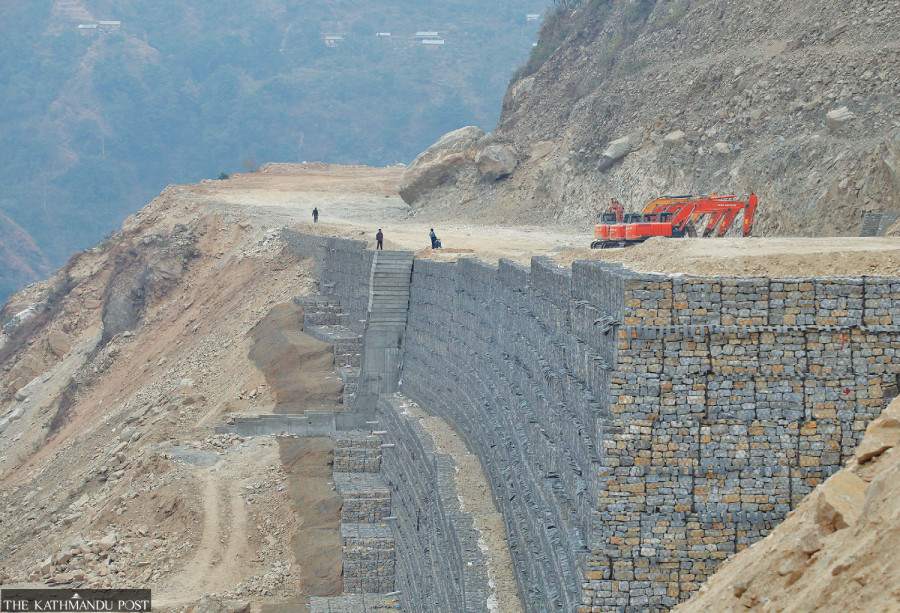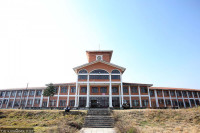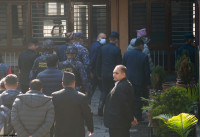National
The many roadblocks to timely completion of expressway
Nepali politicians entrusted Nepal Army with the construction to avoid delays and controversy. Their trust has been belied.
Binod Ghimire
Had the construction of the Kathmandu-Tarai expressway—dubbed fast track as the project was on the drawing board—progressed as planned, it would have been readied two years ago.
The Nepal government on May 4, 2o17 formally handed over the project, under the Department of Roads, to the Nepal Army. The defence force started building the multi-billion-rupee project in August of the same year with a four-year completion target. The snail-paced construction led to multiple extensions of the deadline, the latest set for April 2027.
However, the army leadership, presenting a bleak picture of progress, said earlier this week that the highway might not be ready even three and a half years from now. This has raised questions over the army’s capability. Chief of Army Staff Prabhu Ram Sharma pointed to legal provisions as the major obstacle.
Here is all you would want to know about the project that would shorten the distance between Nepal’s capital city and its most populous Tarai-Madhesh belt.
What led to the expressway idea?
At 71 kilometres, the expressway will be the shortest route between Kathmandu and the east-west highway at Nijgadh, Bara. It was conceptualised in the late 1990s to connect to an international airport in Nijgadh which was being built as an alternative to the busy Tribhuvan International Airport. The highway would connect Kathmandu with the Nijgadh airport, initially touted as the second international airport, in an hour.
The project was stalled for years until the Nepal Army in 2007 shouldered the responsibility to open the track. In 2008, the Asian Development Bank conducted a feasibility study, which projected the estimated cost of the first-of-its-kind highway in Nepal to be Rs70 billion. However, for years, there was no initiative from the government to develop the project. Only in 2013 did the government decide to push ahead with the project.
How did the army get the contract?
In February 2015, the Sushil Koirala government decided to authorise the Indian consortium of Infrastructure Leasing and Financial Services (IL&FS) Transportation Networks, IL&FS Engineering and Construction and Suryavir Infrastructure Construction of India to build the expressway. Bimalendra Nidhi, as the minister for physical infrastructure and transport, signed an initial deal with the consortium. The deal was questioned as the Koirala government offered the developer a minimum revenue guarantee of Rs15 billion a year if traffic failed to generate adequate profits.
It was challenged in the Supreme Court, which in October 2015 issued an order against the deal. The KP Sharma Oli government announced plans to build the project with domestic resources. Then, the Pushpa Kamal Dahal-led government in December 2016 scrapped the deal with the Indian firm, announcing that Nepal would build the expressway on its own.
Nidhi, who was deputy prime minister and home minister in the Dahal Cabinet, was unhappy with the government’s decision. He had publicly lobbied for the Indian firm to be allowed to develop the project.
In May 2017, the Dahal government handed over the undertaking to the army. In August that year, the army started work.
Though Nepal Army has long been involved in opening road tracks in difficult terrains, it doesn’t have the experience of carrying out a mega project. Except for some basic works like clearing mud and chopping trees, the army has awarded several domestic and international firms to carry out the construction, retaining its oversight.
What is the project cost?
The Asian Development Bank study estimated the cost at Rs70 billion. The highway of Asian standard was expected to be built for around Rs112 billion. As per the detailed project report from the Indian firm, the project would cost around $1.12 billion (Rs142 billion in current exchange rate) when built with a soft loan. The cost would have increased in case of a commercial loan.
The revised cost estimate as per the detailed project report prepared by Soosung Engineering Company, a South Korean firm, is Rs213 billion, including contingency spending. With inflation and delays, the price tag will likely increase significantly by the completion time.

Why has the project been delayed?
Nepal Army started construction even before developing a detailed project report. Construction started even as the army was negotiating with the Indian firm to buy the detailed report it had prepared. After this bid failed, the army then turned to the South Korean firm for report preparation in September 2018.
The company presented its report in February 2019 but the government approval would come more than five months later as the estimated cost easily exceeded the Indian firm’s projection. The army, which had earlier claimed that lack of a detailed report was not a problem as it was working based on the feasibility report by the Asian Development Bank, later did a volte-face, saying the unavailability of the report had delayed the project.
Presenting a report card of the project to the State Affairs and Good Governance Committee of Parliament on Wednesday, the army chief said problematic provisions in the Land Acquisition Act and Forest Act were the obstacles for project development.
“If you [lawmakers and government] want the project to be completed on a fast-track basis, you should ensure necessary laws are enacted on the same basis,” he told the House committee. The project was unable to clear the trees on the track for months due to the delay in getting the ministry’s clearance.
He said that at least five months were lost in the wait for explosives from India. The southern neighbour has been obstructing the import of explosives, hindering development works in Nepal. The Covid-19 pandemic and a short supply of construction materials were other reasons Sharma gave for slow construction.
The other factor that delayed construction, which the army does not like to bring up, is the controversy over the selection of bidders. After finding serious procedural flaws, the Public Accounts Committee of Parliament in April 2021 directed the army to scrap the bidding process for the construction of tunnels and bridges in the second phase.
Earlier, in December 2019, the army had to scrap its decision to select six international expressway designing consulting firms after a probe found that the evaluation criteria for the selection of construction and design supervision consultants were leaked to prospective bidders. Months pass in rebidding and selecting new contractors.
“It was a given that the project would not be ready on time. It was wrong to hand it over to the institution that had neither the experience nor capacity to handle such a large-scale project,” a senior official at the Department of Roads told the Post.
After several deadline extensions, the army leadership has started saying that it didn’t ask for the project: it was the government and the political parties that handed over the responsibility to the national army.
How far has the project progressed?
As per the report presented to the House panel on Wednesday, physical progress of the 70.97-kilometre expressway stands at just 28.56 percent. The army has spent Rs52.86 billion on the highway. The national defence force has three and a half years to complete the remaining task.
The project has been split into 13 packages, and the army is yet to award contracts for five of the packages. Selection of bidders takes at least six months. Land acquisition at the entry point at the Khokana-Bungamati area in Lalitpur, in Makwanpur and Nijgadh is yet to be completed as well.
The expressway has six tunnels with a total length of 10.05 kilometres. Construction of three of the six tunnels is yet to start. Similarly, among the 89 bridges with a total span of 12.88 kilometres, construction on 27 has yet to commence.
Will the project be ready by April 2027?
The army leadership itself is not optimistic. Responding to lawmakers’ concerns, Sharma, the army chief, said he could not commit to timely completion in the given setup. “It would be an achievement if we can make the track ready for vehicles by the deadline. After that, the project will take two or three more years,” he said.
No lawmaker airing their view at the meeting was convinced that the army will complete the project in the next three-and-a-half years. Rajendra Pandey, a CPN (Unified Socialist) lawmaker, said the project was handed over to the army for a timely completion and the current progress was disappointing. “The physical progress in the six years is poor. This is not what we expected [while awarding the project],” he said.
Nepali Congress leader Gagan Thapa went on to say that the project, at current pace, could take an extra decade to complete.




 18.12°C Kathmandu
18.12°C Kathmandu













%20(1).jpg&w=300&height=200)

